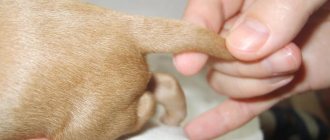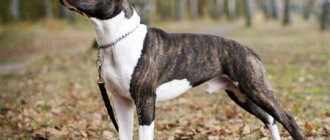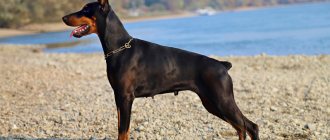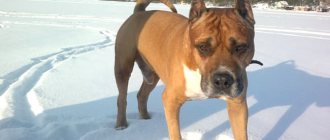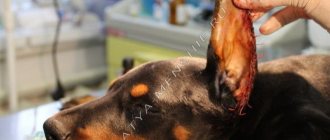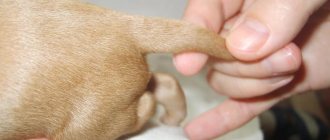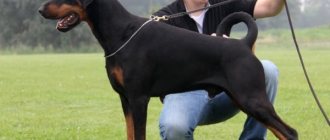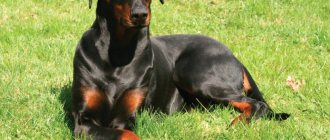A dog's hearing is several times better than that of a human. Thanks to this, your pet senses your approach from afar and meets you at the door. A dog's hearing helps your pet, even in sleep, to listen to any extraneous sounds in order to be ready at any time to sound an alarm and protect you. This acute hearing helps your dog distinguish hundreds of intonations in your voice and respond correctly to what is said. And in order for your pet to retain its amazing abilities, its ears need to be properly cared for.
Types of ears
Different dog breeds have different ears based on the following criteria.
By shape
Depending on the shape of the tips, the ears can be pointed (for example, like a German Shepherd) or rounded (typical for Bassend Hound dogs).
According to the strength and structure of cartilage
In this case, the ears are classified as:
- standing (fully raised above the head);
- semi-erect (the cartilage is strong only in the lower part of the ear, and closer to the tips it becomes thinner and more elastic, causing the ends of the ears to bend down);
- hanging on cartilages (the base of the ears has strong cartilage, but the main part of the ear hangs down - the fold line runs approximately at the level of the forehead);
- hanging (ears hang immediately at the base, without forming a clear break line).
By size
Relative to the size of a dog's head, erect ears can be large, medium, small or small, while floppy ears vary in length and width.
By delivery
Ears can be wide-set, close-set, floppy, high-set, or low-set.
By other criteria
The degree of development of the subcutaneous tissue of the ears (fleshy, folded, dry, heavy), the degree of fouling of the ears with hair, their mobility and other criteria are also taken into account. There are heart-shaped, tulip-shaped, triangular, and even rose-shaped ears.
Each of the listed qualities can determine not only the dog’s compliance with breed standards, but also its temperament. Thus, moving, pointed ears usually indicate the dog’s lively and spontaneous character, sometimes its insatiable curiosity. And low-set, “burdock-shaped” ears often indicate a phlegmatic and philosophical nature of the pet. But this is not always the case, and an enthusiastic beagle with floppy ears may turn out to be more active than a timid Yorkshire terrier. But if all ears are so different, how to properly care for your dog?
History of the cupping procedure
To understand why a dog’s ears and tail should be docked, let’s look at the history of docking. This procedure originates from ancient Rome, where cupping was standard practice.
Docking was popular among owners of fighting dogs. Their ears were removed so that they would lose less blood during dog fights and suffer fewer injuries.
Cupping was also common among shepherds. They removed the tails of their dogs to avoid rabies, because they believed that the disease originated from the tail.
Later, ear and tail docking began to be done for various reasons. The main reason is the breed of the dog and its purpose. This is how hunting, fighting and service dogs are most often docked. In some cases, refusal of this procedure may lead to a deterioration in the dog’s performance.
- In the Middle Ages, docking was a distinctive feature of noble dogs.
- So, in the town of Weimar, which is located in Germany, in the 18th century, peasants began to be subject to a tax related to dogs.
- The nobles, in order to identify their dogs, removed their tails.
- Also in Britain, all dogs were taxed, with the exception of guard dogs, whose tails were docked to distinguish them from other breeds.
Features of ear care
To ensure proper ear care for your pet, you should follow several general principles.
Maintenance must be regular
After each walk, you should inspect the dog’s ears in order to notice and remove ticks in time (ears, paws and tail are favorite places of attachment). Once a week, the ears need to be examined in more detail, looked into the ear canal, and, if necessary, cleaned and treated. To clean and disinfect your ears, you can use Bars lotion, which has disinfecting properties and facilitates the removal of dirt, earwax and secretions resulting from infectious or inflammatory diseases of the ears.
Care must be gentle
Dogs' ears are very sensitive and vulnerable. Therefore, for cleaning you should use only safe tools and products approved for use in veterinary practice. To clean the inside of the ear, place 2-5 drops of warm lotion inside. Then, soak a swab or cotton pad in the lotion, gently wipe the inside of the ear. After this, change the disc and soak it in the lotion again, gently wipe the curls at the base of the ear, without going deeper. These steps should be repeated until the surface of the cotton pad remains clean. You should not clean the inside of your ear with chopsticks; it is too easy to cause damage.
Care must be rational
If your dog has a lot of hair on the inside of the ears (especially long hair), it should be trimmed regularly with round-edged scissors or plucked according to breed standards. Long hair protects the pet's ear canal to a certain extent. But it also prevents the removal of dirt and wax from the ears and serves as a reservoir of impurities that can harm the dog’s health.
Reasons for removing a dog's ears and tail
The reasons for docking are quite varied, they all depend on the breed of the dog and the characteristics of individual breeds.
Let's look at some reasons for cupping:
- Hunting breeds are most often docked to avoid unwanted injuries. So, some breeds have their tail removed in order to pull the dog out of the hole.
- Some owners of fighting dogs believe that pointed ears give the dog a more menacing and intimidating appearance.
- In addition to aesthetic reasons, fighting dogs are docked due to a predisposition to ear diseases. For example, docking Doberman Pinscher ears and tails is a common practice for aesthetic reasons and reasons for common ear diseases. Cupping will reduce the risks of such diseases to a minimum.
- The popularity of ear and tail docking is due to tradition. People follow standards and amputate ears and tails because this is the custom among owners of certain breeds of dogs.
Traditionally, the removal procedure is performed at an early age. After all, ear and tail docking in puppies is less painful than in adult dogs.
How to train a dog to clean its ears?
Correct and effective cleaning of dog ears is only possible if the animal itself is favorable to the procedure. In this case, it will not spin around or try to escape.
It’s easy to accustom your pet to regular ear cleaning:
- For the first few cleanings, make sure your dog is fed, walked, and in a good mood. If your pet is not feeling well or is sick and ear cleaning can wait, reschedule it for a more convenient time.
- Talk to the dog in an even, calm tone, pat its withers, or perform any action with which you usually approve or praise your pet.
- Sit down and have your dog sit in front of you - for the first time this can be done comfortably by placing your pet between your knees and squeezing him lightly. Make sure you have everything you need on hand - tampons and discs, ear cleaning lotion.
- Carry out cleaning carefully, making sure not to hurt the dog with careless or too strong movements.
- After completing the procedure, praise your pet and treat him with a treat.
Types of cupping operations
Cupping can be divided into complete and partial. Before going to the clinic for this procedure, you should research these two types of surgery and understand which type is right for your dog.
- Complete cupping of the auricle involves its almost complete removal. This type of docking is suitable for the Alabai and Caucasian Shepherd breeds. Partial cupping involves incomplete removal of the ear, but only part of it. Thus, for Dobermans and Great Danes, only the tip of the ear is removed, which gives them a sharp shape. For other breeds, their own standards are established.
- Tail docking also has its own characteristics. Full tail docking is popular among dogs like Doberman, Rottweiler and Boxer. Some breeds have half the organ removed (Spaniels and Hungarian Pointers). For example, in the photo of the docked ears and tail of a Doberman, we see that its tail has been almost completely removed, and its ears have a pointed shape.
Comparing the price of ear docking and tail docking, we can say that ear docking will cost more due to the complexity of the operation. Therefore, before choosing the type of operation, you need to find out how much it costs to crop a dog’s ears and tail from your nearest veterinarian or clinic.
Types of Dogs Based on Body and Head
According to these criteria, dogs were divided into 6 morphological types: molossers, greyhounds, hounds, dachshunds (that is, with shortened limbs), spitz (foxes) and wolfdogs (based on their resemblance to wolves, foxes and other similar dogs):
- Molossers - have a massive and round or conical head, a fairly short muzzle, thick and drooping lips, a clearly defined stop, a massive and durable body (for example, a French bulldog, bullmastiff, Rottweiler).
- Greyhounds - they have a long and pointed head with a narrow skull, small and broken (semi-erect) ears, some breeds have erect ears, they also have a long and thin muzzle, an almost invisible and poorly defined posture, an arched nose, thin and close-fitting lips, a slender figure and thin and long limbs, as well as a toned stomach (for example, Russian Greyhound, Irish Wolfhound, Italian Greyhound).
- Beagle dogs - they have a prism-like head, as well as a massive muzzle, floppy ears, long and drooping lips, a clearly defined posture, a fairly massive but strong silhouette (for example, Beagle, Bloodhound, Bavarian Hound, Weimaraner, German Shepherd) .
- Dachshunds are dogs with shortened limbs, disproportionately short in relation to the body, their silhouette is shaped like a taxi, some have crooked legs (e.g. Pekingese, Dachshund), others have straight legs (e.g. Corgi). Dogs with this body type occur in different groups of dogs: dachshunds, companion dogs (such as the Pekingese), shepherds (such as corgis), terriers and hounds.
- Spitz - their head has a wider skull and a light muzzle, similar to the muzzle of a fox. They also have small and erect ears, long hair, a curled tail on the back, and their silhouette is relatively massive with strong paws (eg, Chow Chow, Basenji, Samoyed, Malamute).
- Wolf dogs - the head resembles a long cone, the ears are straight and pointed, the muzzle is elongated and narrow, the lips are thin and tight, the stop is clearly defined, the silhouette is very proportional and massive, they also have strong paws.
Preparing your dog for ear cropping
Before cupping, you need to make certain preparations:
- It is now quite popular to call a doctor and have surgery at home. This is not the best solution. It is difficult to create the necessary conditions (sterility) at home, and it will be easier for a specialist to carry out the procedure in a clinic.
- Before docking, as before any surgical operation, it is necessary to consult a veterinarian. Clearly discuss all the steps with him: contraindications, preparation, procedure, caring for the pet in the postoperative period.
- Check your pet's ears for mites, dirt, or damage. This will protect the puppy from infection.
- A week before the planned procedure, it is necessary to monitor the pet’s health. If there is any deviation, the operation should be rescheduled and you should talk to your veterinarian.
- You cannot feed your pet 12 hours before ear cropping.
- 40 minutes before the procedure, you should disinfect the auricle with hydrogen peroxide. It also wouldn't hurt to remove hair at the docking site.
Surgery and rehabilitation process
The tail and ear docking operations themselves differ from each other.
The tail surgery procedure is done in two ways:
- Docking a puppy three days after birth. This is the most painless method of cupping, because it does not require anesthesia and does not require sutures.
- Another way is to use an elastic band (ligature). It is placed at the end of the tail, which blocks access to the blood vessels. After a couple of days, the tip of the tail will fall off on its own.
Ear cropping is a little more complicated, since anesthesia is already required here, because the operation is quite painful. After cupping, the wounds are sutured and treated. This procedure lasts from thirty minutes to one and a half hours.
The rehabilitation process is quite an important part of this procedure, because it is necessary to study all the nuances associated with this in order to avoid possible complications.
Let's consider some points of the postoperative period:
- Cropped puppies should be monitored for several hours to prevent bleeding.
- It is necessary to purchase a special “collar” for the dog to prevent it from scratching the wounds and causing infection. If the dog is in pain, painkillers are prescribed.
- It is necessary to frequently treat seams with antibacterial agents.
- After two weeks, the stitches are removed.
Briefly about the main thing
- Droopy long ears are considered by scientists to be a genetic defect maintained by selection.
- Each breed has its own standard for ear length.
- Droopy ears will require more care.
- The ears may be covered with smooth, shiny fur, fine hairs or curls.
- The general condition of the dog, its activity, and longevity depend on the health of the hearing organs.
- When choosing a breed, you need to focus on personal preferences, find out in advance the character and natural inclinations.
- Dogs with long ears have lower levels of aggression.
Dog head anatomy
A dog's head consists of two main parts called:
- craniofacial,
- visceral (also known as the facial part of the head).
The craniofacial structure includes the following morphological elements of the dog's head:
- ears,
- occiput (nuchal tumor, the back of the head, located on the top of the head),
- temples with zygomatic arches turning into cheeks.
The visceral skull, on the contrary, includes:
- the whole dog's face,
- bridge of the nose,
- the tip of the nose, which is called a truffle,
- upper lip,
- lower lip.
At the boundary of the craniofacial and visceral bones lie: the frontonasal fracture, which is called the stop (stop, the forehead of the dog, it is considered determining for this limit) together with the anterior angle of the head (the stop forms this angle together with the line of the back of the head, passing towards back of the head), eyes and eyelids. The head continues to the neck, which joins the body. Behind the head, when viewed from above, there is a cervical region called the occiput (the area at the back of the head). On the sides there are sides of the neck, and looking from below there is a dewlap.
